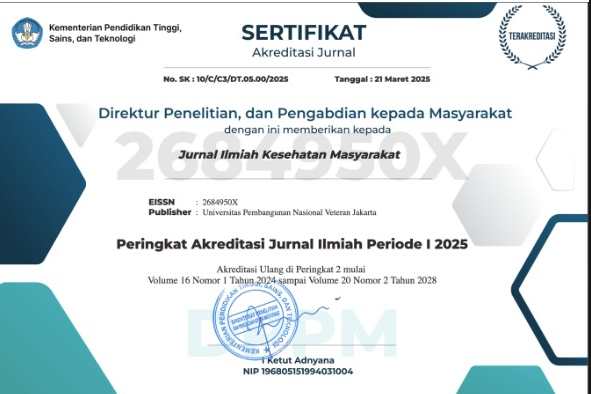Penegakan Cause of Deaths Neonatal Menggunakan InterVA-4 Versi 4.04 di Bandingkan dengan Diagnosa Cause of Deaths ICD-10 di Kecamatan Ciputat Periode Tahun 2016-2017
Abstract
Abstrak
Latar Belakang: Data penyebab kematian adalah sumber penting perencanaan kebijakan kesehatan, tetapi ketersediaan dan kualitas data kurang di banyak bagian dunia, verbal autopsy dapat dijadikan suatu alternatif terhadap sistem pencatatan angka dan penyebab kematian yang kurang baik pada suatu wilayah namun memiliki permasalahan penafsiran verbal autopsy dengan andal dan konsisten agar bisa sampai pada penyebab kematian.
Metode: Survei kepada komunitas di Kecamatan Ciputat untuk mendapatkan informasi kasus kematian neonatal pada tahun 2016-2017, ditindak lanjuti dengan verbal autopsy kepada keluarga yang mengetahui kematian kasus dan dilakukan penegakan diagnosa cause of death dengan InteraVA-4 kemudian dibandingkan dengan data Dinkes dan hasil telaah dokumen Puskesmas.
Hasil: Data cause of death Kota Tangsel berdasarkan SRS 2016 adalah gangguan pernafasan dan kardiovaskular (50,7%). Hasil cause of death di Kecamatan Ciputat berdasarkan data AMP Dinkes tahun 2016 asfiksia (60%) dan 2017 setengah dari data tidak memiliki cause of death sama seperti data puskesmas tahun 2016, pada 2017 asfiksia (25%) menjadi cause of death neonatal. Hasil cause of death InterVA-4 tahun 2016 asfiksia (43%) dan 2017 asfiksia (28%). Perbandingan cause of death InterVA-4 memiliki kesamaan 70% pada data Dinkes, perbandingan dengan puskesmas memiliki 66,7% kesamaan dan hasil telaah dokumen dengan menginput kedalam sofware memiliki kesamaan 70%.
Kesimpulan: InterVA memiliki kesamaan yang cukup baik dengan data Dinkes dan Puskesmas dalam menentukan diagnosa cause of death. InterVA merupakan alat yang sederhana, murah dan kongsisten dalam menetapan cause of death.
Enforcement Cause of Deaths Neonatal Using InterVA-4 Version 4.04 Compare with Diagnosis Cause of Death ICD-10 in Ciputat District, period 2016-2017
Abstract
Background: Cause of death data are public health planning essential sources, but their availability and quality are lacking in many parts of the world, verbal autopsy can be made for alternative recording and causes of death that are not good in the area but have verbal autopsy interpretation problems reliably and contrast in order to arrive at the cause of death.
Methods: Survey of communities in Ciputat Subdistrict to obtain information on neonatal mortality cases in 2016-2017, followed by verbal autopsy to families who knew case deaths and diagnosed cause of death with InteraVA-4 then compared with Dinkes data and results. review of Puskesmas documents.
Results: South Tangerang City's cause of death data based on SRS 2016 are respiratory and cardiovascular disorders (50.7%). The result of cause of death in Ciputat Subdistrict based on AMP Dinkes data in 2016 asphyxia (60%) and 2017 half of the data did not have cause of death as well as data from Puskesmas in 2016, in 2017 asphyxia (25%) became neonatal cause of death. The result cause of death InterVA in 2016 asphyxia (43%) and 2017 asphyxia (28%). Comparison of cause of death InterVA-4 has 70% similarity in Dinkes data, comparison with health center has 66.7% similarity and document review results by inputting into software have 70% similarity.
Conclusion: InterVA has good similarities between the data of the Dinkes and Puskesmas. InterVA is a simple, inexpensive and consistent tool in the cause of death.
References
WHO. Newborns: reducing mortality [Internet]. 2018 [cited 2018 Mar 10]. Available from: http://www.who.int/news-room/factsheets/detail/newborns-reducing-mortality.
WHO. Civil registration: why counting births and deaths is important. Civil registration: why counting births and deaths is important. 2014.
Byass P. Whither verbal autopsy? Popul Health Metr [Internet]. 2011;9(1):23. Available from: https://doi.org/10.1186/1478-7954-9-23
WHO. Neonatal and Perinatal Mortality. 2006.
KeMenKes RI. Profil kesehatan Indonesia tahun 2016. Jakarta Kementeri Kesehat Republik Indones. 2016;
WHO. Verbal Autopsy Standars: The 2016 WHO Verbal Autopsy Instrument, WHO Libarry Catatoguing-in-Publication Data. 2017.
WHO. WHO | Family planning/Contraception. WHO [Internet]. 2016 [cited 2017 Mar 27]; Available from: http://who.int/mediacentre/factsheets/fs351/en/
Fantahun M, Fottrel E, Berhane Y, Wall S, Högberg U, Byass P. Assesing a new approach to verbal autopsy interpretation in arural Ethipian community: the InterVA model. Bull World Health Organ [Internet]. 2006;84(5). Available from: https://doi.org/10.2471/BLT.05.028712
Byass P, Herbst K, Fottrell E, Ali MM, Odhiambo F, Amek N, et al. Comparing verbal autopsy cause of death findings as determined by physician coding and probabilistic modelling: a public health analysis of 54000 deaths in Africa and Asia. J Glob Health [Internet]. 2015;5(1):10402. Available from: https://doi.org/10.7189/jogh.05.010402
Weldearegawi B, Melaku YA, Dinant GJ, Spigt M. How much do the physician review and InterVA model agree in determining causes of death? a comparative analysis of deaths in rural Ethiopia. BMC Public Health [Internet]. 2015;15(1):1–7. Available from: https://doi.org/10.1186/s12889-015-2032-7
Mengesha HG., Sahle BW. Cause of neonatal deaths in Northern Ethiopia: A prospective cohort study. , 17(1), 1–8. BMC public Heal Heal [Internet]. 2017;17(1):1–8. Available from: https://doi.org/10.1186/s12889-016-3979-8
Byass P. Usefulness of the Population Health Metrics Research Consortium gold standard verbal autopsy data for general verbal autopsy methods. BMC Med [Internet]. 2014;12(1):1–10. Available from: https://doi.org/10.1186/1741-%0A7015-12-23 %0A
Powell-Jackson T, Neupane BD, Tiwari S, Morrison J., Costello A. Support to Safe Motherhood Programme. Safe Motherhood. Nepal; 2005. (April), 1–9.









.jpg)








